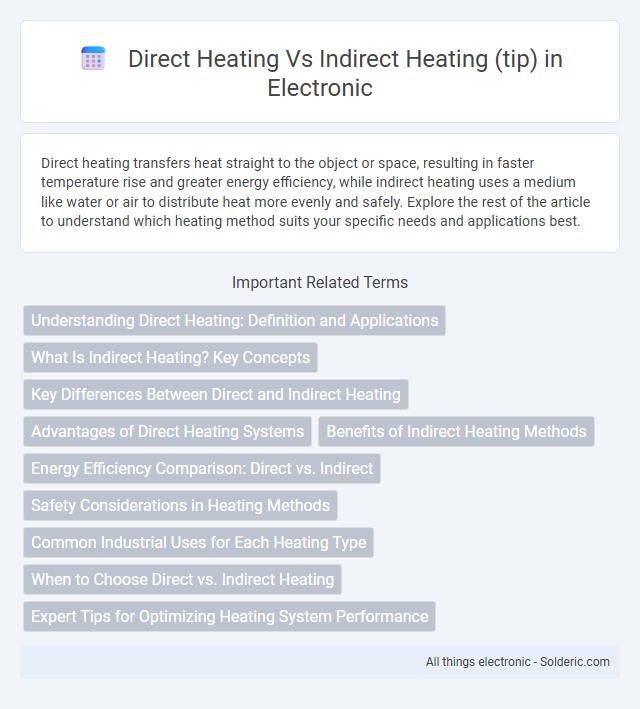Direct heating transfers heat straight to the object or space, resulting in faster temperature rise and greater energy efficiency, while indirect heating uses a medium like water or air to distribute heat more evenly and safely. Explore the rest of the article to understand which heating method suits your specific needs and applications best.
Comparison Table
| Feature | Direct Heating | Indirect Heating |
|---|---|---|
| Heating Method | Heat applied directly to the object or surface | Heat transferred via an intermediary medium (e.g., water, steam, oil) |
| Efficiency | Higher energy efficiency due to minimal heat loss | Lower efficiency due to heat transfer losses |
| Temperature Control | Less precise; heat can be uneven | Precise, consistent temperature control |
| Applications | Cooking, welding, direct flame heating | Boilers, heat exchangers, sterilization, sensitive processes |
| Safety | Higher risk of burns and fire hazards | Safer due to containment of heat source |
| Equipment Cost | Generally lower initial investment | Higher cost due to heat transfer systems |
| Maintenance | Simple maintenance | Complex maintenance required for heat transfer media and components |
Understanding Direct Heating: Definition and Applications
Direct heating involves transferring heat directly to the target surface or material through contact or radiation, resulting in rapid temperature rise and efficient energy use. Common applications include cooking with open flames, infrared heaters, and industrial processes like metal forging, where precise and immediate heat control is essential. Understanding direct heating helps you select appropriate methods for tasks requiring quick and localized heating.
What Is Indirect Heating? Key Concepts
Indirect heating involves transferring heat to a material without direct contact between the heat source and the substance being heated, often using an intermediate medium like steam or hot oil. This method ensures uniform temperature distribution, reduces the risk of hot spots, and prevents contamination or degradation of sensitive materials. Understanding indirect heating can help you optimize processes in industries such as chemical manufacturing, food processing, and pharmaceuticals where precise temperature control is crucial.
Key Differences Between Direct and Indirect Heating
Direct heating transfers energy straight to the material, resulting in rapid temperature changes and higher energy efficiency. Indirect heating uses an intermediary medium like water or steam to distribute heat evenly, providing better temperature control and reducing hotspots. Understanding these key differences helps you choose the most effective method for your industrial or household heating needs.
Advantages of Direct Heating Systems
Direct heating systems provide rapid and efficient heat transfer by delivering warmth straight to the desired area without energy loss through intermediate fluids. These systems often result in lower operational costs and quicker temperature control, enhancing your overall comfort and energy savings. Their straightforward design simplifies installation and maintenance, making them a practical choice for both residential and commercial applications.
Benefits of Indirect Heating Methods
Indirect heating methods offer enhanced temperature control and uniform heat distribution, reducing the risk of hot spots and material degradation. These techniques improve safety by preventing direct contact with open flames or heating elements, minimizing fire hazards. Your processes benefit from increased energy efficiency and prolonged equipment lifespan due to reduced thermal stress.
Energy Efficiency Comparison: Direct vs. Indirect
Direct heating transfers energy straight to your target, minimizing heat loss and achieving higher energy efficiency compared to indirect heating methods that rely on intermediary mediums. Indirect heating often involves energy dissipation during transfer, reducing overall efficiency and increasing operating costs. Optimizing your system for direct heating can lead to significant energy savings and improved performance.
Safety Considerations in Heating Methods
Direct heating involves exposing materials to an open flame or heat source, increasing the risk of burns, fire hazards, and gas leaks, while indirect heating uses a barrier or medium to transfer heat, enhancing safety by reducing direct contact with flames. Your choice should consider the specific environment and material sensitivity, as indirect heating generally offers better control and minimizes accidental overheating or ignition. Safety protocols, such as proper ventilation and monitoring systems, are crucial regardless of the heating method to prevent accidents and ensure consistent temperature regulation.
Common Industrial Uses for Each Heating Type
Direct heating is commonly used in industrial processes requiring rapid temperature changes, such as metal forging, glass manufacturing, and food processing, where heat is applied directly to the material. Indirect heating finds its primary application in industries demanding precise temperature control and contamination-free environments, including chemical reactors, pharmaceutical production, and semiconductor manufacturing. Both heating types optimize energy use and process efficiency tailored to specific operational needs.
When to Choose Direct vs. Indirect Heating
Direct heating is ideal when rapid temperature increase and high energy efficiency are required, such as in industrial processes like drying or melting. Indirect heating suits applications needing precise temperature control and contamination-free heat transfer, including chemical reactors or food processing. Assess your system's sensitivity and heating speed requirements to determine the best choice for your operational needs.
Expert Tips for Optimizing Heating System Performance
Expert tips for optimizing heating system performance emphasize choosing between direct and indirect heating based on your space requirements and efficiency goals. Direct heating delivers immediate warmth by heating the air or objects directly, ideal for localized heating, while indirect heating transfers heat via a medium such as water or air in ducts, offering energy efficiency for entire buildings. Understanding these differences helps you maximize comfort and reduce energy costs by selecting the best option for your specific application.
direct heating vs indirect heating (tip) Infographic

 solderic.com
solderic.com